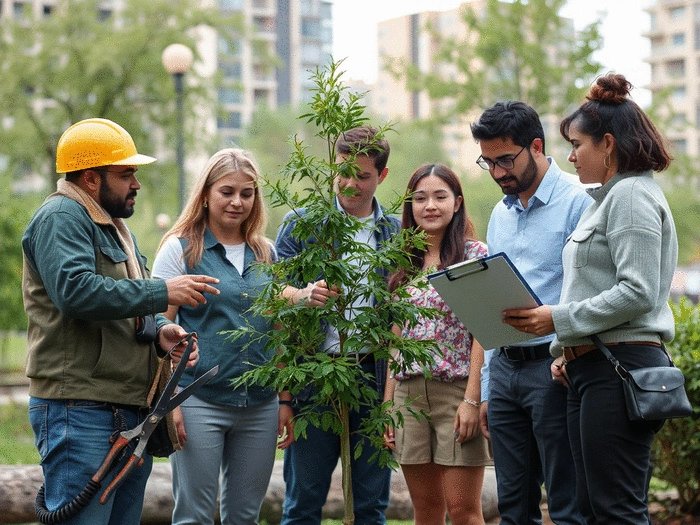Sustainable Tree Care in Cities

Posted on: 2025-10-15
By: Keira Vallejo
Urban forests are more than just a collection of trees; they are vital ecosystems that enhance our urban environments. As cities expand, the need for sustainable tree maintenance becomes increasingly essential. How can you ensure your city’s trees thrive for generations to come? Let's explore the critical components of an effective maintenance plan.
What You Will Learn
- Understanding the multifaceted benefits of urban forests, including environmental, social, and economic impacts.
- Key components of a sustainable urban tree maintenance plan, such as assessing tree health and community engagement.
- Establishing clear metrics for success, including tree health assessments and community involvement.
- Strategies for fostering community engagement and education through volunteer programs and workshops.
- Learning from successful urban tree initiatives in cities like New York, Seattle, and San Francisco.
Key Performance Indicators for Urban Tree Maintenance
Monitoring urban tree maintenance is crucial for success. Below are important KPIs to track the effectiveness of your maintenance plan.
Tree Health Assessments
Regular evaluations to identify issues early.
Canopy Coverage
Percentage of urban areas shaded by trees.
Species Diversity
Variety of tree species in your urban forest.
Community Engagement
Level of local resident involvement in tree care.
How to Create a Sustainable Urban Tree Maintenance Plan: A Step-by-Step Guide
Creating a sustainable urban tree maintenance plan is essential for maintaining the health and vitality of our city landscapes. Urban Canopy Blog is dedicated to guiding you through this process, ensuring that your efforts not only benefit the trees but also enhance the community as a whole. Let's dive into the key components that will make your plan effective and sustainable!
Understanding the Importance of Urban Forests
Have you ever thought about how urban forests contribute to our daily lives? They offer an array of benefits that are vital for both the environment and our communities. From improving air quality and providing shade to enhancing aesthetic beauty, urban trees play a crucial role in creating a healthier city experience.
Moreover, they foster social connections and promote economic growth. When people gather in green spaces, it leads to stronger community ties. Trees can even increase property values! Can you believe that a single tree can make such a profound impact?
- Environmental Benefits: Clean air, reduced heat island effect, and improved biodiversity.
- Social Benefits: Spaces for recreation, community gatherings, and mental well-being.
- Economic Benefits: Increased property values and savings on energy costs.
Key Components of a Sustainable Urban Tree Maintenance Plan
To craft an effective maintenance plan, there are several core components you should consider. Each element plays a role in ensuring that your urban trees thrive over the long term. Here’s a list to get you started!
- Assessing Tree Health: Regular evaluations help identify problems early.
- Pruning and Care: Proper pruning encourages strong growth and maintains safety.
- Watering and Soil Management: Healthy soil and adequate hydration are essential for tree vitality.
- Community Engagement: Involve local residents to enhance care efforts and foster responsibility.
By incorporating these components into your plan, you're setting the stage for a thriving urban canopy! It's essential to keep in mind the unique needs of your city and its trees as you develop your strategy. Remember, a successful plan is one that not only addresses tree care but also considers the community's role in nurturing this green infrastructure.
Establishing a Vision and Goals for Urban Tree Care
Now that we've outlined the importance of urban forests and their maintenance, let's shift our focus to establishing a clear vision for your urban tree care efforts. This vision will serve as the guiding light for your sustainable maintenance plan. Stay tuned for more insights, as we continue to explore this vital topic!
Before we continue, let's address some frequently asked questions about urban tree maintenance:
Frequently Asked Questions (FAQs)
- Why are urban forests important?
- Urban forests provide numerous environmental, social, and economic benefits, including improved air quality, community spaces, and increased property values.
- What are the key components of a sustainable urban tree maintenance plan?
- Key components include assessing tree health, proper pruning and care, effective watering and soil management, and active community engagement.
- How can I monitor the effectiveness of my urban tree maintenance plan?
- Establish key performance indicators (KPIs) such as tree health assessments, canopy coverage, species diversity, and community engagement levels.
- What are some ways to encourage community engagement in urban tree care?
- Organize volunteer tree care days, offer workshops and training sessions, and partner with local schools to incorporate tree education into the curriculum.
- Are there successful examples of urban tree maintenance initiatives I can learn from?
- Yes, cities like New York City, Seattle, and San Francisco have implemented effective urban forest programs that emphasize community involvement and sustainability.
Pro Tip
Did you know? Engaging local businesses in your urban tree maintenance efforts can significantly enhance community involvement. Consider reaching out to them for sponsorship or collaborative events, such as tree planting days. This not only fosters a sense of responsibility but also provides businesses with an opportunity to showcase their commitment to sustainability!
Monitoring and Evaluating the Effectiveness of Your Maintenance Plan
Once you've established a solid urban tree maintenance plan, it's crucial to monitor and assess its effectiveness. This process not only ensures that your trees are thriving but also helps you identify areas for improvement. Like any dedicated urban forestry expert will tell you, ongoing evaluation is key to a successful long-term strategy!
Establishing Metrics for Success
To effectively gauge the success of your maintenance plan, consider defining key performance indicators (KPIs). These metrics will help you track progress and demonstrate the positive impact of your efforts. Here are some important KPIs to consider:
- Tree health assessments: Regularly check the condition of trees to identify any issues early.
- Canopy coverage: Measure the percentage of urban areas shaded by trees.
- Species diversity: Monitor the variety of species in your urban forest.
- Community engagement: Gauge the level of involvement from local residents in tree care activities.
By tracking these indicators, you'll get a clear picture of how well your urban forestry initiatives are performing. Plus, it makes your efforts more visible to stakeholders and community members alike!
Regular Reporting and Community Feedback
Engaging the community in the monitoring process can create a sense of ownership and pride in local urban forests. Encourage residents to provide feedback on the health and aesthetics of trees in their neighborhoods. You might consider establishing:
- Feedback forms: Simple questionnaires for residents to share their observations.
- Progress reports: Regularly published updates on tree care initiatives.
- Community forums: Meetings where residents can discuss their ideas and concerns.
By facilitating open communication, you not only improve your maintenance plan but also strengthen community ties. It’s amazing what a little collaboration can achieve!
Encouraging Community Engagement and Education
Building Volunteer Programs and Educational Initiatives
Involving local residents in tree maintenance efforts is a fantastic way to promote sustainability and educate the community. Here are some strategies to encourage participation:
- Volunteer tree care days: Organize events where families can come together to plant, prune, or mulch trees.
- Workshops and training: Offer sessions on basic tree care techniques, fostering a knowledgeable community.
- School partnerships: Collaborate with local schools to incorporate tree education into the curriculum.
These initiatives not only enhance the health of your urban forest but also create a sense of community pride. When people feel connected to their surroundings, they’re more likely to care for them! You might even promote community pride during specific seasons with seasonal care for city trees.
Case Studies: Successful Urban Tree Maintenance Initiatives
Learning from the successes of other cities can inspire and inform your own urban tree maintenance efforts. Here are a few examples of cities that have implemented effective plans:
- New York City: The MillionTreesNYC initiative aimed to plant and care for one million trees, engaging thousands of volunteers.
- Seattle: The Green Seattle Partnership combines city resources with community volunteer efforts to restore forested areas.
- San Francisco: Their Urban Forest Program emphasizes sustainability, biodiversity, and community involvement.
These case studies illustrate the power of collaboration and effective planning in fostering healthy urban forests. Each city has its unique approach, and you can adapt these lessons to your community!
Public Engagement through Community Workshops
Workshops can be a fantastic way to educate the public about urban forestry practices! By organizing hands-on sessions, you can inspire residents to take action. Consider these workshop ideas:
- Tree identification walks: Teach locals how to identify different tree species in their neighborhoods.
- Pest management seminars: Share knowledge on natural pest control methods for healthy trees.
- Pruning clinics: Demonstrate proper pruning techniques to encourage healthy growth.
Workshops not only foster knowledge but also build relationships among community members. By coming together for a common cause, you can truly make a difference!
Conclusion and Call to Action for Sustainable Urban Forestry
Summarizing Key Steps for a Successful Urban Tree Maintenance Plan
As we wrap up, it’s essential to recap the key steps for creating a sustainable urban tree maintenance plan. From establishing clear metrics for success to engaging the community through workshops, each step plays a vital role. Don’t forget that tree care is an ongoing commitment and requires collective effort! For additional support, consider the benefits of professional tree care to ensure your trees thrive.
Resources for Further Learning and Implementation
If you're looking for resources to help implement your urban tree maintenance plan, check out our downloadable templates and guides at Urban Canopy Blog. Together, let’s cultivate healthier urban ecosystems and inspire community engagement in tree care! So, what are you waiting for? Let's get started today!
Recap of Key Points
Here is a quick recap of the important points discussed in the article:
- Importance of Urban Forests: Urban trees provide environmental, social, and economic benefits, improving air quality, enhancing community ties, and increasing property values.
- Key Components of Maintenance Plan: Regular health assessments, proper pruning, effective watering and soil management, and community engagement are essential for tree vitality.
- Establishing Vision and Goals: A clear vision guides your urban tree care efforts and ensures a sustainable maintenance strategy.
- Monitoring Effectiveness: Define key performance indicators (KPIs) like tree health assessments and community engagement to gauge the success of your maintenance plan.
- Community Engagement: Foster community involvement through volunteer programs, educational workshops, and feedback mechanisms to strengthen local ownership of urban forests.
- Learning from Success: Examine case studies from other cities to adapt successful strategies to your own urban tree maintenance initiatives.
 In urban environments, trees are often the unsung heroes contributing to our well-being and the over
In urban environments, trees are often the unsung heroes contributing to our well-being and the over
 Urban trees are essential to our cities, yet they face numerous threats from pests and diseases. Did
Urban trees are essential to our cities, yet they face numerous threats from pests and diseases. Did
 Did you know that urban tree diversity is crucial not just for aesthetics, but for the health of ent
Did you know that urban tree diversity is crucial not just for aesthetics, but for the health of ent